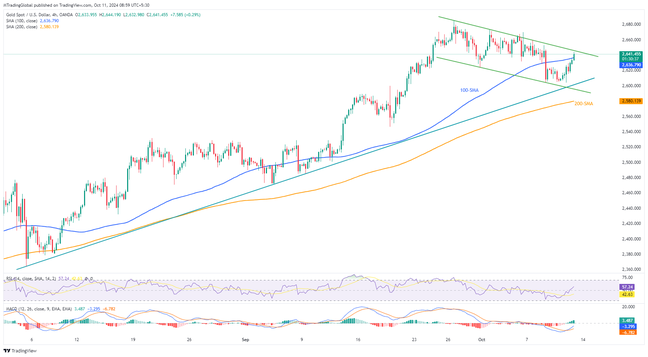Gold prices continue to recover after the US inflation data, despite staying within a two-week bearish trend. Early Friday, buyers look forward to the first readings of the University of Michigan Consumer Sentiment Index and Consumer Inflation Expectations for October, along with the September Producer Price Index (PPI).
Bulls brace for fresh record high
Whether it's the US Dollar's muted reaction to better-than-forecast Consumer Price Index (CPI), optimism around potential stimulus from China, or expectations of softer US data, gold prices aim for a fresh all-time high. Technically, the recent breakout above the 100-SMA, bullish MACD signals, and a positive RSI (14) reinforce the upward momentum.
Technical levels to watch
Among the key technical levels, $2,647 gains immediate attention as it comprises the top of the bearish channel, a break of which will defy the fortnight-long bearish chart pattern. Following that, the precious metal’s quick jump toward the all-time high surrounding $2,685 can’t be ruled out. Moreover, a clear breakout past $2,685 would signal strong momentum for gold buyers, potentially paving the way for a rise beyond the $2,700 mark.
On the downside, the 100-SMA at $2,636 provides immediate support for gold prices, alongside an upward-sloping trend line from early August near the $2,600 mark. If XAUUSD falls below $2,600, the focus will shift to the bottom of the bearish channel and the 200-SMA, which are near $2,595 and $2,580, respectively. Notably, if prices break below $2,580, gold could enter a short-term bearish trend, potentially targeting the $2,540-$2,530 range.
Upside looks promising
With expectations of lower Fed rates and potential softness in upcoming US data, combined with bullish technical indicators, gold prices seem poised for upward movement. This bullish outlook could change only if the US statistics challenge the likelihood of two more rate cuts from the Federal Reserve, which would negatively impact the US Dollar—an outcome that appears unlikely.
Join us on FB and Twitter to stay updated on the latest market events.

